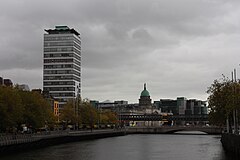Liberty Hall
| Liberty Hall | |
|---|---|
| Halla na Saoirse | |

Liberty Hall, the headquarters of SIPTU with the Custom House, Butt Bridge and Loopline Bridge in the background
|
|
|
Location of Liberty Hall in central Dublin
|
|
| General information | |
| Status | Complete |
| Architectural style | Postmodern |
| Address | Eden Quay |
| Town or city | Dublin, Ireland |
| Coordinates | 53°20′54″N 6°15′19″W / 53.3483°N 6.25527°W |
| Construction started | 1961 |
| Completed | 1965 |
| Affiliation | The headquarters of the Services, Industrial, Professional and Technical Union |
| Height | |
| Tip | 59.4 m (195 ft) |
| Technical details | |
| Floor count | 16 excluding ground floor |
| Design and construction | |
| Architect | Gilroy McMahon |
| Known for | Dublin's third tallest storeyed building |
Liberty Hall (Irish: Halla na Saoirse), in Dublin, Ireland, is the headquarters of the Services, Industrial, Professional, and Technical Union (SIPTU). It was formerly the tallest storeyed building in the state, at 59.4 metres, (195 feet) high until it was superseded by the County Hall outside Cork city, which was itself superseded by The Elysian in Cork. Liberty Hall is now the third tallest building in Dublin, after Montevetro (now Google Docks) and the Millennium Tower in Grand Canal Dock.
Liberty Hall is more historically significant in its earlier form, as the headquarters of the Irish Transport and General Workers Union early in the 20th century, and also as the headquarters of the Irish Citizen Army (ICA).
Standing on Beresford Place and Eden Quay, near the Custom House, the original Liberty Hall was a hotel before it became headquarters of the Irish Citizen Army. During the 1913 Dublin Lock-out a soup kitchen for workers' families was run there by Maud Gonne and Constance Markievicz. Following the outbreak of the First World War a banner reading "We Serve Neither King nor Kaiser, But Ireland" was hung on its front wall, and ICA's newspaper, The Irish Worker, was printed inside. The newspaper was shut down by the British government for sedition under the Defence of the Realm Act. It was replaced for a short time by a paper called The Worker until that too was banned. Connolly edited a third paper, The Workers' Republic, from 1915 until the Easter Rising in 1916.
...
Wikipedia

